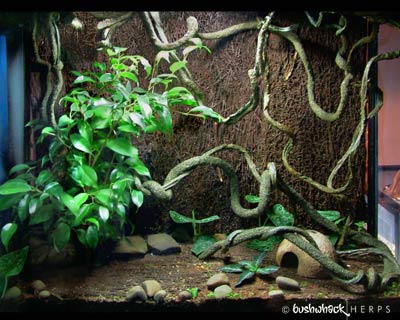[enclosure design]
Captive pets spend most of their life in an enclosure many times smaller than the great outdoors, therefore it is of utmost importance that we provide them with habitats where they feel safe, comfortable, and with plenty of space and "furnishings" to enrich their lives. When designing an enclosure, carefully consider the natural behavior of the species that will be living in it. For example, Waxy Monkey Frogs will need appropriately sized branches and vines at varying distances from their heat source in order to bask at the correct temperature. On the other hand, Crested Geckos like to climb and jump, but also need a cozy, secure place to curl up and sleep during the day.
Pictured above is a crested gecko enclosure. This is a 39 gallon glass/screen combination tank (30x25x12" or 76x64x30cm). Tree fern panel lines the back of the tank and covers 2-3" substrate on the bottom. Hardy, non-toxic live pants (Ficus, Pothos, etc) have been inserted through small holes in the tree fern panel so that their roots reach the soil underneath. The fern panel prevents accidental ingestion of substrate when the geckos are feeding. Twisted jungle vines hang throughout the tank so the geckos can climb and jump. And my geckos love to sleep in coconut huts! Since I took this picture the plants have grown quite a bit and I have also added an egg-laying box. 
Another very important consideration is safety. While the enclosure itself must obviously be sturdy, roomy and secure, the items put into it must also be safe. Any plants, decorations, and furniture must be non-toxic and appropriate for the species. Substrate must be used with care since it can be accidentally or intentionally ingested by the animal and cause impaction and death.
Generally enclosures with live plants are more aesthetically pleasing (assuming the plants are healthy), and the animals really seem to enjoy them. While naturalistic setups sometimes require more upkeep, with careful planning and a little creativity, they can be not only beautiful, but practical and easy to maintain.
Pictured on the right is an example of a basic crested gecko setup. This particular enclosure is about 30 gallons (16x15x29" or 40x38x74cm). Screen cages like these are easy to clean (simply remove geckos & decor, take outside and hose it out). You can also hose off the fake plant/vine. A cage of this size can house 1-3 adult geckos. For this enclosure, I also have a couple sheets of acrylic plexi that I have carefully cut to fit snugly on the outside of the enclosure (fits right into the metal framing). I use these when I want to boost/maintain the humidity within the enclosure (sometimes screen cages can dry out a bit, even if you mist several times a day).
